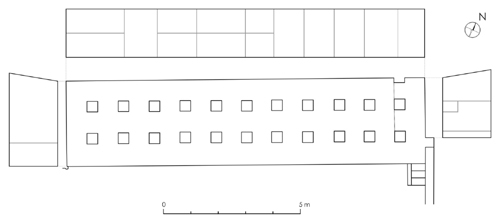News
Middle Portico South (Portico of Punt)

The Southern Middle Portico is located in the southern part of the Middle Terrace of Hatshepsut’s temple of millions of years at Deir el-Bahari. It is often referred to as the Punt Portico, due to the fact that it is decorated with the most extensive representations of an Egyptian Punt expeditions known to date, the latter having been organised by Hatshepsut in regnal year 9 of Thutmose III. The reliefs of the Punt Portico had been published for the first time already in 1877 by Auguste Mariette. The unique and unparalleled representations, including the famous ‘queen of Punt’ very quickly became famous non only among Egyptologists, but also among the general public, which contributed greatly to the theft of some of the blocs of the south wall, even before the appearance of Marriete’s publication (some of them are currently kept in the museums in Cairo, London, and Brussels, but some were never recovered). One had to wait for a new publication of the reliefs of the Southern Middle Portico until 1898, when the third volume of the monumental work of Édouard Naville, with the drawings by Howard Carter, was published.
The Southern Middle Portico, just as its northern counterpart, is composed of two rows of eleven pillars decorated with the figures of Hatshepsut and Thutmose III in the company of Amun. The scenes referring to the Punt expeditions were placed on the inner walls of the portico.
The first of the scenes is located on the southern end of the west wall, where the moment of the arrival of the Egyptian fleet to Punt was represented. Then, the action moves to the south wall, where, in the lowermost register we see the meeting of the Egyptian expeditionary force led by Nehes with the elders of Punt, whose leaders are Parehu and his wife Iti (called ‘the queen of Punt’). The original bloc with the depiction of the ‘queen of Punt’ is presently kept in the Egyptian Museum in Cairo, while its copy was inserted to the wall. In the upper part of the wall we see the transportation of the Puntite (in the middle register) and Nubian (in the upper register) products to Egyptian ships. Special attention should be paid to the detailed representation of water fauna (including river and sea species) as well as exotic animals (including a giraffe and a rhinoceros). The eastern end of the same wall is covered by a fragmentarily preserved inscription describing sending a granite statue depicting Hatshepsut in the company of Amun-Ra to the land of Punt.
Then, the action comes back to the west wall, where in the middle register we see the loading of Egyptian ships with the Puntite and Nubian goods as well as the departure of the fleet back to Egypt. Above the ships we see a procession of Puntites and Nubians carrying gifts for the Egyptian king. In the following scene a presentation of the imported goods to Hatshepsut is depicted. Among the products brought from the land of Punt we can see both plants (myrrh trees) and animals (leopard, cheetahs, giraffe) as well as various precious products (ebony, ivory, electrum). In the next scene we see weighing and measuring various Puntite and Nubian goods. The weighing is made by the gods (Dedwen, Horus, and Seshat) while the measuring by the royal officials directed by Djehuti and supervised by the god Thoth. Then, we can see Hatshepsut (whose image has been hacked out and replaced by a representation of six standards at a later date) and Thutmose III, making offerings for the sacred bark of Amun, carried by a group of priests. The depiction of the bark was destroyed in the Amarna period and restored in Ramesside times. The cycle of depictions of west wall is closed by a scene representing the seated god Amun and Hatshepsut standing in front of him. The scene is accompanied by a long inscription describing Amun’s oracle concerning Hatshepsut’s Punt expedition. Hatshepsut’s figure as well as the inscription itself were hacked our by the order of Thutmose III, while Amun’s image was destroyed by the order of Akhenaten and subsequently restored by Ramesses II.
On the north wall we see Hatshepsut enthroned wearing the atef-crown in front of whom there are three officials: Nehes, leader of the Punt expedition, Senenmut as well as a third person being a symbolic representation of all other royal officials. In the great inscription accompanying the scene Hatshepsut announces to her courtiers her decision concerning sending an expedition to Punt. The figures of Hatshepsut and her courtiers as well as the texts accompanying the scenes were later hacked out by the order of Thutmose III. In the season 2014/2015 a new documentation process of the scenes of the Southern Middle Portico was inaugurated, thanks to which it will be possible to prepare a new publication of the reliefs of this part of Hatshepsut’s temple, analysing not only various phases of the decoration of the portico, but also the significance of the portico both in the functioning of the whole temple and in Hatshepsut’s ideology of kingship.
Text by: Filip Taterka



